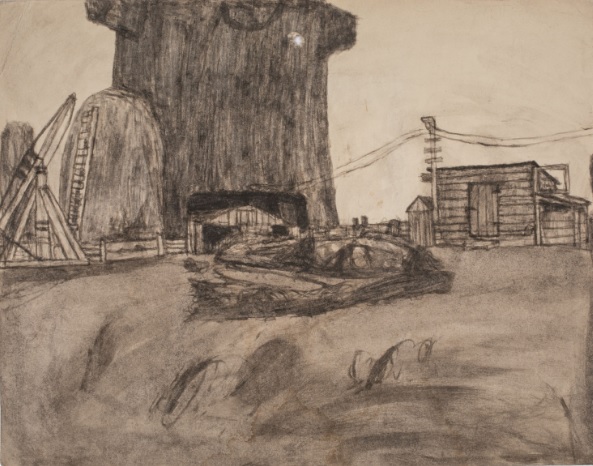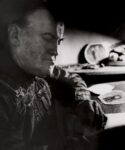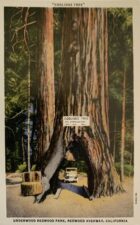
James Castle
American, 1899-1977
Farmscape with Giant Sequoia, n.d.
soot on found paper
10 1/4 x 13 1/8 in.
James Castle Collection and Archive

James Castle working at his desk (photograph housed at the James Castle Collection and Archive)

Underwood Redwood Park, Redwood Highway, California
COMMENTS
Castle’s recollections could be fictionalized, or mediated through popular culture. Several drawings feature an enormous imagined tunnel tree. This is a motif Castle played with often, one that was inspired by tourist postcards of the novelty found in California redwood forests—enormous trunks of live trees carved with a channel wide enough for a car to drive through. Several such postcards published by CurtTeich and Company, Chicago, between 1933 and 1935 were found in Castle’s ephemera collection after his death. He spliced this image into several farm scenes, along with other items from the farm that apparently whetted his curiosity: a large hoist for stacking hay or straw, towering haystacks, tall ladders, electric power lines and poles. In one, a power line seemingly passes through the tree tunnel; in another, the tunnel completely swallows up a shed. This is Castle’s landscape at its most inventive. He is creating scenes that are clearly half-real and half-fictive, combining his own memories with images appropriated from commercially available sources.
This is just one of many ways Castle created fictions out of remembered scenes. Haystacks and trees turn into massive monoliths, or they become almost architectonic, rising in profile like the side of a hill or the gable end of a building. Monoliths topple, or they get replaced by oversized machinery. Castle also submitted landscape to the most abstract and atmospheric of transformations. Various components are extremely simplified—hills or haystacks are reduced to basic cones. Buildings become horizontal lozenges that seem to float in space; one even resembles a tin can hovering over its own shadow. Some of these landscapes are simply ground and sky with a wavering horizon between them.
- John Beardsley, James Castle: Memory Palace, Yale University Press, New Haven, 2021, 98-100
SBMA CURATORIAL LABELS
Castle made countless drawings of the family farm outside of Boise, depicting the house, outbuildings, and, once in a while, the twenty-three-by-eight-foot Cozy Cottage trailer that served as his home and studio for the last fifteen years of his life. The trailer which was parked immediately beside the house (and is still there to this day), was purchased for Castle in 1962 by his sister, Peggy Wade, using money from some of the first sales of his artworks. Other sheets show the small Castle house, with its stark. asymmetrical facade, and surrounding outbuildings, rendered in such a way as to indicate their rough-hewn qualities. Despite the casual, “slice-of-life” nature of many of these drawings, which include household appliances and crates randomly strewn around the yard, these images are imaginatively conceived as well. Note the implausibly tall beehive-box stacks looming in the background of one drawing, and the giant sequoia tree that miraculously appears on the family property in others. Castle never traveled to California and was familiar with the magnificent sequoias only through photographs in magazines and in a tourist postcard that was found among his possessions after he died.
- The Private Universe of James Castle, 2023
